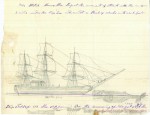 In November of 1820, the Nantucket whaling ship Essex was rammed twice by an 85-foot sperm whale as its crew harpooned the whale’s podmates. The whale won and the Essex sank, a full 1500 nautical miles west of the Galapagos Islands.
In November of 1820, the Nantucket whaling ship Essex was rammed twice by an 85-foot sperm whale as its crew harpooned the whale’s podmates. The whale won and the Essex sank, a full 1500 nautical miles west of the Galapagos Islands.
The ship’s captain, George Pollard, Jr., the first mate, Owen Chase, and the second mate, Matthew Joy, each took command of a whaleboat and a third of the crew. Thus began 90 plus days of survivalist hell, complete with delirium, deprivation and ultimately cannibalism, until the 8 barely surviving members of the crew were rescued.
Captain Pollard was one of the survivors. Traumatized by having eaten his young cousin, whom he had sworn to protect, and although he made some bad calls that contributed to the disaster, he was given command of another whaler, the Two Brothers, after his return to Nantucket. His luck did not change, sadly, and the Two Brothers hit a reef on French Frigate Shoals, northwest of Honolulu, and sank in February of 1823. That was the end of Captain Pollard’s career. He went back to Nantucket and spent the rest of his days as a night watchman.
The wreckage of his life would find a form of immortality, however, in Herman Melville’s Moby Dick. Melville met Owen Chase’s son when they were both serving on different whalers in the early 1840s, and Chase lent him his father’s memoirs of the Essex tragedy. This account was a major inspiration for Moby Dick. Melville would seek Pollard out in the early 1850s after Moby Dick was published and they apparently had quite the meeting of the minds.
Now archaeologists from the National Oceanic and Atmospheric Administration’s Office of National Marine Sanctuaries exploring the French Frigate Shoals area have found the wreck of the Two Brothers. Whaler shipwrecks are rarer than hen’s teeth, because most of them sank in high seas, not near the shore. This is in fact the first Nantucket whaler ever found. The only other one in existence is the Charles W. Morgan which was honorably retired after 80 years of service and is now a National Historic Landmark on display at Mystic Seaport Museum in Connecticut.
Kelly Gleason, the leader of the team, was in the water — crystal-clear shallows about 15 feet deep — when a colleague suddenly signaled that he had seen something.
“All of a sudden,” said Dr. Gleason, a marine archaeologist, “we came across this large anchor.”
The anchor, some 10 feet long, was peacefully resting on the seafloor, and was far too heavy to lift. (The federally protected monument also has strict rules about removal of artifacts.) Anchors, like so many other types of maritime technology, evolved over the years, making them easier to place in a specific time period, and Dr. Gleason was pretty sure the anchor she was seeing was from the early 1800s.
Divers soon found more debris, including several iron trypots, cauldrons in which blubber was boiled down into oil, the ultimate goal of the lucrative but highly speculative whaling trade. It was a brutal pursuit for both the whales, which were hunted nearly to extinction, and the sailors, who faced years at sea, meager rations and the omnipresent possibility of death.
 Archaeologists have found around 80 total artifacts from the ship, including rigging, blubber hooks, ceramics and cast iron cooking pans. They are hoping to put some of the smaller pieces on permanent display in Hawaii, but the large scale items like the anchors will remain on the ocean floor.
Archaeologists have found around 80 total artifacts from the ship, including rigging, blubber hooks, ceramics and cast iron cooking pans. They are hoping to put some of the smaller pieces on permanent display in Hawaii, but the large scale items like the anchors will remain on the ocean floor.
For more details about the find and some beautiful high resolution pictures of the finds, see the NOAA website.
Death is an omnipresent possibility in every endeavor. :skull:
Cannibalizing your cousin a little less so.
These days you need a liberal arts degree for that.
At least if you cannibalize your cousin you do not have to worry about leaving a carbon footprint.
Always look on the bright side of death. :giggle:
:skull: :hattip: :giggle: 👿